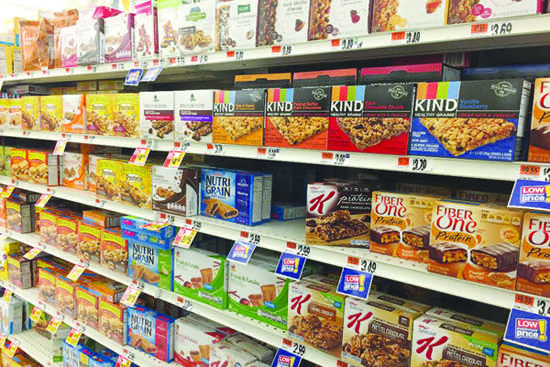Atoms have unbreakable sweet teeth

Granola bars found in supermarkets and the Jock Lobby snack bar can lose their intended health benefits with added sugars
By now, the message that sugar is bad for your health is not a foreign concept. It is something most doctors and diet gurus agree on.
Besides adding empty calories and spiking blood glucose levels, consuming mass amounts of sugar can contribute to weight gain and increase the risk of going into cardiac arrest.
A study published in JAMA Internal Medicine in 2014 found that people who ate close to 20 percent of their daily calories from added sugar had a 38 percent higher risk of dying from heart disease than those who ate half as much.
Sugar has a hold on a lot of people because one, it is everywhere, two, we are born to like it, and three, it has been proven to be addictive.
The same study that was published in JAMA Internal Medicine proved that humans naturally have an inborn preference for sweet and sugary items.
“I find that sugar can be really addictive if you are not careful,” junior Katie Garrish said. “A lot of foods that I love probably have a lot of sugar in them, which is not good.”
Sugar is hard to avoid because it is practically everywhere. On average, a person will consume 27 calories of the substance, which is equivalent to almost 17 teaspoons.
“I do not find sugar to be that addictive because it is something that gets old and sickening after a while,” sophomore Shirley Chu said. “It is also really unhealthy which makes me want to stay away from it.”
Since this study, more and more research has come forward proving that sugar is addictive, not just in the loose, vernacular sense, but in the same way drugs can be addictive. Several studies on animals have shown that sugar acts as a stimulant to the brain and the consumer develops a dependence for it.
A study from Duke University that was published in the journal Neuron showed that mice who were given a fixed amount of sugar daily had significant changes in their brain patterns and developed drug addict like symptoms.
These studies do not necessarily mean that one should cut off all candy or certain cereal brands.
The studies are proving that sugar should be enjoyed in moderation and the amount of sugar being consumed should be monitored.
Most doctors say that sugar should not be an all or nothing porportion.
Most of the time, foods with high amounts of sugar can be detected right off the bat.
Foods such as candy bars, juices and cereals are easily seen. However, sugar is also in foods such as breads, yogurts, dressings, crackers and condiments.
“I probably do eat too much sugar from day to day,” junior Janu Gellert said. “I am trying to end this bad habit.” Sugar can come in many shapes and forms.
On most food labels, uncovering the exact amount of the sweet substance can be a chore.
I always check for the nutrition facts when I purchase food,” junior Iris Arrazola said.”I like to know what food I am eating and what is in it. It also helps because I know what’s going in my body.”
While most of them list the sugar contained in the food itself, they do not contain the amount of sugar added.
Adding this feature to all food labels will be a topic discussed at the upcoming revision of the nutrition fact labels.

Sabrina is a senior at Annandale and this is her fourth year on staff. She started out her first year as the sports editor, then the health editor and...










